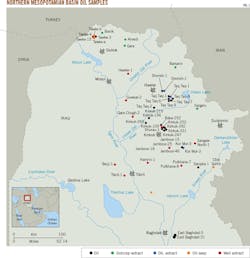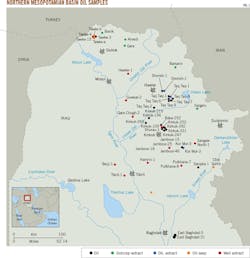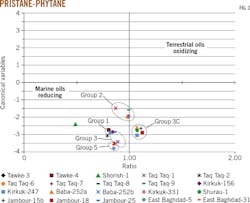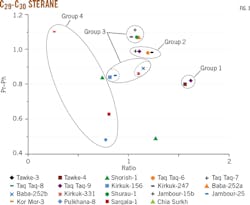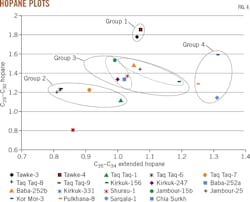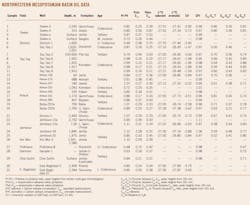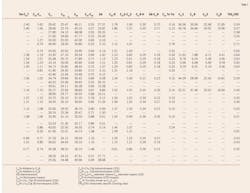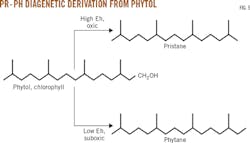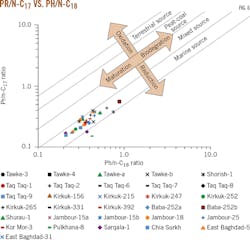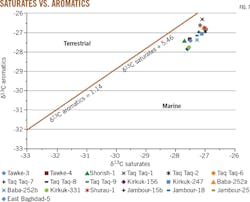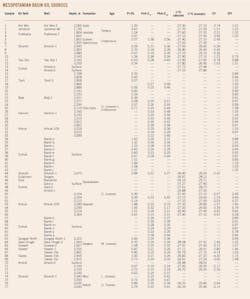Geochemistry links source rocks, crude distribution in northern Mesopotamian basin, Iraq
Rzger A. Abdula
Soran University
Soran, Kurdistan Region,
Iraq
Mesopotamian basin exploration in Iraq has opened 73 oil fields since the late 1920s. Most fields are in the northern and southern parts of the basin, but several lie in western Iraq. Researchers have focused on geochemical features of particular source rocks and crude oils, but the absence of an inclusive analysis on oil samples across the basin has obstructed understanding of the general geological and geochemical setting of existing hydrocarbons in the region.
The Mesopotamian basin encompasses oils from differing source rocks including carbonates and mixtures of marl and shale. This study geochemically reevaluates 31 crude oil samples along with 77 source-rock samples to identify genetic classes for the region's crude oils and define source-rock ages and depositional environments in the northern Mesopotamian basin (Fig. 1).
Oil-source classification
The northern Mesopotamian basin contains five diverse oil groups (see accompanying Box) (Figs. 2-4). Geochemical constraints display a carbonate source in a reducing setting for all samples except those from East Baghdad, which show evidence of marl-source contribution. Biomarker constraints do not indicate molecular input from Triassic sources, also excluding East Baghdad samples. Lower and Middle Jurassic sources contributed to oils in Tawke, but Taq Taq oils show no molecular contribution. Kirkuk and Garmain oils generated from various sources including Jurassic, Cretaceous, and Tertiary but with different proportions of each.
Sample selection for this study included 28 crude oil and three oil seep samples from 12 oil fields. Researchers collected the source rock samples from 14 oil wells and five outcrops in the northern Mesopotamian basin. Biomarker configurations and constraints guided investigation of the paleo-environmental and depositional environments and oil geochemical grouping.
In addition to the five oil groups, Kirkuk oils further divide into three subgroups based on gammacerane, C28-C29 steranes, Pr-Ph ratios, and carbon preference index (CPI). The first subgroup is in the northwest part of the basin has Pr-Ph proportions <0.87 with sufficient gammacerane. Homohopane 22S/(22S+22R) isomer ratios show maturity within the first group of oils. Oils from the southeast part of the region, by disparity, have Pr-Ph proportions >1 and relatively scarce C29 steranes. Triaromatic steroids (TAS) values indicate immature thermal maturity for the basin's southeastern oils, except Kor Mor condensate which ranges from mature to over mature.
Homohopane ratios and TAS values propose early maturity levels for Jurassic Kirkuk oils. Upper Jurassic Taq Taq oils, similar to the Tawke oils sourced from Lower to Middle age, have CPI values and Pr-Ph proportions <1, which suggests marine sources (algae and bacteria).
The study observed higher ratios of C28-C29 sterane with lower gammacerane content in the basin's eastern oil samples. TAS values and Pr/n-C17-Ph/n-C18 ratios proved this group to have the highest level of thermal maturity. The East Baghdad oils have the highest canonical variable (CV) values of wax content and low Pr-Ph ratios, suggesting a marine-reducing depositional source. Gammacerane is high in both East Baghdad oil samples and their thermal maturity is intermediate according to their Pr/n-C17-Ph/n-C18 ratios.
Source-rock classification
Mesozoic and Cenozoic sedimentary rocks are generally 3-km thick, but have been recorded as thick as 9 km.1 Effective source rocks include Middle-Upper Jurassic Sargelu, Naokelekan, and Chia Gara marine strata, which occur throughout the basin, and the Lower Tertiary Kolosh-Aalaiji and Jadala formations in the central portion of the region.2-7
Middle-Upper Jurassic strata in the northern Mesopotamian basin consist mainly of marine carbonate and shale deposited in moist climates. These source rocks may adjoin through the region as the northwestern and southeastern parts of the basin are geochemically comparable.8
Upper Jurassic-Lower Cretaceous sediments consist of shelf-environment limestone and shale strata with a source-rock prospective.9 Middle and Upper Jurassic source rocks in the northern Mesopotamian basin consist of limestone, shale, and marly limestone. The carbonate and shale have average total organic carbon (TOC) contents of 1.10-20.69% and different kerogen types with prevalent Type II kerogen.2 4 10 Maturities are inconsistent in Middle-Upper Jurassic source rocks, but they range from mature to highly mature based on Tmax measurements.11 12
During the Paleocene-Eocene, source rocks were deposited under anoxic, reduced-marine carbonate environments. Taq Taq samples in Aaliji-Kolosh beds show sources of oxidizing terrestrial organic matter.7 Primary Tertiary source rocks are Paleocene Kolosh, Paleocene-Lower Eocene Aaliji, and Early Eocene-Late Eocene Jaddala formations. The Kolosh formation consists of shales, sandstones, chert, and radiolarite deposited in a marginal marine depositional environment in a narrow, rapidly subsiding trough.13 The Aaliji formation consists of gray and light brown argillaceous marls, marly limestones, and shales with occasional microscopic fragments of chert and scattered glauconite.8 The formation was deposited in an offshore, open-marine environment lying between two belts of platform margin carbonate shoals.13 The Jaddala formation consists of argillaceous and chalky limestones and marls, with occasional thin intercalations of shoal limestones deposited in a basin lying between two belts of carbonate shoals.8
Variations in sedimentary facies during basin progression caused horizontal discrepancies in source rock appearances in the northern Mesopotamian basin. Data from the Taq Taq oilfield suggest that flysch-mollase settings governed through the Paleocene-Early Eocene, with open-marine deposition limited to the western part.14 Rock appearance changes gradually southwest-northeast in the basin. TOC content declines from 1.08 to 0.51 wt % in Paleocene source rocks and from 2.83 to 2.20 wt % in Eocene source rocks. Organic matter deviates from diversified to humic as maturity rises.7
Sample methodology
Researchers extracted 108 geochemical data points from 17 subsurface and six surface sections of boreholes and outcrops in the northern Mesopotamian basin from previous studies (Tables 1 and 2).2-5 7 10 11 15-17
Physical and chemical properties of the northern Mesopotamian oils vary with specific gravities ranging from 0.85 g/cu m (medium-light) to 0.92 g/cu m (heavy). Specific gravity can be as low as 0.79 g/cu m (Bina Bawi) and as high as 1.0 g/cu m (Bastora and Benenan). Samples from Kor Mor-3 (KM-3) condensate had specific gravities as low as 0.72 g/cu m.17 Viscosities are 7.9-25.2 millipascal seconds (mPa·s). Mixed Kirkuk and East Baghdad samples show respective pour points of -9° and -24° C. and sulfur contents of 3.3 and 3.4 wt %.18
Fuel oils produced from Tawke crude have a higher sulfur content (5.0 wt %) at 350° C.19 H2S content can be as high as 12.8 ppm and salt content can reach 26.4 mg/l., such as in East Baghdad crude.18 Vanadium content was high in Tawke samples, registering 10 ppm for crude oil. Fuel oil at 300 °C. and 350 °C. contained 36 and 40 ppm, respectively.19
Oil group classification
Earlier studies geochemically typed oils in the Iraqi Kurdistan region into the Lower-Middle Jurassic Tawke, Upper Jurassic Taq Taq, and Kirkuk groups.5 10
The heterogeneous relationship among oils in Kirkuk oil field suggests further subgrouping. But plotted biomarkers and isotope parameters do not suggest a strong link between Kirkuk oils. Oils from the K-247 and K-331 wells display a miscellaneous relationship between the Tertiary and Cretaceous reservoirs.5
Lower-Middle Jurassic Tawke oils
Group 1 holds CPI values above 1.0 and Pr-Ph proportions of ≤0.87 (Fig. 2 and Table 1). A low Pr-Ph proportion designates anoxic hypersaline depositional settings (Fig. 5).20 21 Previous studies provide a chart of Pr/n-C17 against Ph/n-C18 that can designate oil maturity. It shows that source rock for the oils in the northwestern Mesopotamian basin was deposited in a reducing setting (Fig. 6).22 Gammacerane is high in all western oil samples, indicating a common hypersaline depositional oil source (Table 1).23
The richness of C27-C29 steranes in oils can also establish source rock's depositional settings. Samples in the northwestern part of the region have high quantities of algal-originated C27 steranes (Table 1). Pr/n-C17 and Ph/n-C18 proportions also support the algal-bacterial organic input to these oils.
In addition to high gammecerane, lower C28-C29 sterane ratios confirm a Lower-Middle Jurassic aged-source.24
Previous studies have established oil-source rock relations with carbon isotope proportions for oils and organic matter.25 Carbon isotope proportions for northwestern oil samples range -27.34-27.52‰ inicating a marine-organic source (Fig. 7 and Table 1). CV analysis distinguishes waxy and nonwaxy oils. Ta-3 and Ta-4 oils had respective CV values of -2.90 and -2.72, indicating both came from a nonwaxy source.
Upper Jurassic Taq Taq oils
Group 2 oils have CPI values >1.0 and Pr-Ph proportions <1 (average 0.93), indicating a marine-organic matter origin (Fig. 2 and Table 1).20 21 This group's Pr/n-C17-Ph/n-C18 ratios suggest marine-source rock that was deposited in a reducing marine environment (Fig. 6).
Higher C28-C29 sterane ratios indicate Upper Jurassic age. Lower gammacerane content in eastern oils also supports the group's Upper Jurassic age (Table 1).24 The low C28-C29 sterane value (0.53 for TT-1) may be related to oil maturity level.3 TT-1 and TT-2 oil samples showed no oleanane content, indicating that the oils are sourced from rocks older than Cretaceous or from sources with no angiosperm content.7 TT-1 oil samples' gammacerane index (gammacerane-hopane C31) is 0.1, indicating a low salinity depositional environment for the initial organic matter.26 Observed differences between the oil of the Upper Eocene Pila Spi reservoir in the TT-2 well and the oil of Upper Cretaceous reservoirs in the TT-1 well are interpreted as additional contributing sources to the Jurassic and Cretaceous beds. Possible candidates include Paleocene beds in the accumulated oil of the Upper Eocene Pila Spi reservoir or certain kinds of degradations.7
C35S-C34S proportions >0.8 along with C29 norhopane-C30 hopane >0.6 suggest a carbonate source under reducing and anoxic-marine environments.21 High C22-C21 ratios coupled with low C24-C23 ratios verify a carbonate source under marine reducing settings.27
The carbon isotopic compositions of eastern oil samples fluctuate between -26.30 and -27.21‰ with an average of -26.85‰ and CV less than 0.47 (Fig. 2 and 9). Carbon isotope parameters and CV indicate a nonwaxy oil source.25 Carbon isotope fraction content increases occasionally with lower ages and appears unrelated to source-rock type.28 This difference exists between both groups as the average carbon isotope ratio is -27.12‰ for Group 1 and increases to -26.85‰ for Group 2, indicating Tawke's oil source is older than Taq Taq's.
Jurassic-Tertiary Kirkuk oils
The genetic connection among Group 3's oils requires biomarker ratios because the oils appear to have multiple sources. The abundant C28-C29 sterane ratio ranges 0.52-0.88, indicating a Lower-Middle Jurassic to Tertiary age (Table 1). Gammacerane content in Kirkuk oils also differentiates the oils and suggests mixed origin. The gammacerane concentration varies from 26.7 to 0.01 ppm and indicates that Lower-Middle Jurassic sources are contributing in different proportions. The Pr-Ph ratios also have a wide range (0.72-1.12). Combined input of C28-C29 sterane, gammacerane concentration, and Pr-Ph ratios, proposes three subgroups: 3-A, 3-B, and 3-C.
Subgroup 3-A includes K-252 oil, which has the lowest Pr-Ph ratio, 0.72, and C28-C29 sterane ratio, 0.52 (Fig. 2 and 8). K-252 has the highest gammacerane concentration and CPI: 1.01 (Table 1).
Subgroup 3-B includes oils from K-156, K-215, B-252b, K-265, K-331, K-392, Ja-15a, and Ja-25. These can be categorized together as they have intermediate Pr-Ph ratios from 0.84 to 0.91 (Fig. 2 and Table 1), C28-C29 sterane ratios of 0.66-0.74, low gammacerane concentration, and CPI of 0.94-1.11 (Table 1).
Subgroup 3-C includes K-247, B-252a, Shu-1, Ja-15b, and Ja-18 and has the highest Pr-Ph ratio, 1.07-1.12 (Fig. 2 and Table 1), the highest C28-C29 sterane ratio, 0.78-0.88, CPI of 0.95-1.06, and the lowest gammacerane concentration, 0.01-0.11 (Table 1). K-247 was the exception with 6.58 gammacerane concentration. Oil samples analyses identified low ratios of gammacerane-hopane C31, which indicate a low salinity depositional environment for the initial organic matter. Excluding Pr-Ph ratios, the remaining observations point to oil-source influence from freshwater depositional conditions.
The Subgroup 3-B oils have carbon isotopic compositions fluctuating between -26.80‰ and -27.73‰. Subgroup 3-C oils have carbon isotopic compositions between -26.74‰ and -27.30‰, indicating that Subgroup 3-B oils are older than 3-C oils (Fig. 7).
Cretaceous-Tertiary Garmian oils
Group 4 oils hold high CPI values, 0.98, and low Pr-Ph ratios with the exception of KM-3's high Pr-Ph ratio, 1.10, which suggest a marine-organic origin (Fig. 2 and Table 1).29 The >1 Pr-Ph proportion suggests an origin with high amounts of plant material. This is characteristic of coal-sourced oils, but the ratio may also point to higher maturity as in the case of KM-3's condensate-formed samples.
Charting Pr/n-C17 against Ph/n-C18 illustrates reducing-environment source-rock deposition and suggests that the oils originated from marine-source rocks (Fig. 6). Pr/n-C17 and Ph/n-C18 proportions are characteristic of a marine setting (Table 1).22 The small amount of C29 steranes compared to C27 and C28 steranes suggests a marine-organic input (Table 1). These observations show that a reducing, mature-marine carbonate likely sourced discovered hydrocarbons. This group is further characterized by a predominance of n-alkanes, high values of short vs. long chain n-alkanes, and abundant C27 regular sterane.11
This study confirmed carbonate source rocks deposited under an anoxic-marine environment with the geochemical results of tricyclics, tetracyclics, and hopanes with an abundance of homohopane series and low diasterane-sterane ratios, together with low ratios of dibenzothiophene-phenanthrene (DBT/P). Small amounts of gammacerane indicate normal salinity conditions during oil-source deposition.11 Higher C28-C29 sterane ratios (1.16, 1.19, 1.38, and 1.48 for Sq-1, Pu-8, KM-3, and CS, respectively) indicate Cretaceous to Tertiary age.24
Middle Triassic-Upper Jurassic East Baghdad oils
Unlike oils from other groups, Group 5 holds the highest CV values--3.6 and -3.79 for EB-5 and EB-31, respectively-and low Pr-Ph ratios, 0.85, (Fig. 2 and Table 1), proposing a marine-organic origin.25 29 High CV values and low Pr-Ph proportions conflict with abundant C29 steranes (Table 1). Gammacerane is high in both East Baghdad oils, a characteristic commonly linked with a hypersaline depositional setting (Table 1).23 30
Contrasting other groups, Group 5's relative concentrations of C29 steranes-47.51% and 49.96% for EB-5 and EB-31, respectively-are higher than concentrations of C27 and C28 steranes. The δ13C enrichment is detected in oils worldwide between the Triassic-Jurassic boundary, and these variable ratios can differentiate Triassic oils from younger oils in the northern Mesopotamian basin.28 East Baghdad oils have carbon isotopic compositions of -27.56-27.87‰ (Fig. 7). This range is lower than the range of oils in other groups. Excluding the low C28-C29 sterane ratios, it is probable this group has an older age. The results point to input from continental organic matter, and the oils in this group may have originated from different sources.
Thermal maturities
Oil maturity is determined through a variety of biomarker constraints such as homohopane ratios 22S/(22S+22R), sterane, hopane isomer ratios, CPI, Ts-Tm, Pr-Ph, and Methylphenanthrene Index 1 (MPI 1).
Molecular maturity constraints such as sterane, hopane isomer proportions, and CPI values designate that the Group 4 oils are mature. The ratio of Ts-Tm and MPI 1 is reliable and indicates the maturity sequence from high to low: KM-3 > CS > Sq-1 > Pu-8.11 Maturity indicator biomarkers such as steranes, Pr-Ph, and CPI show that oil from TT-2 is more mature than oil from Ja-25.7
The results from northern Mesopotamian basin suggest that the homohopane-bishomohopane for Tawke oils lies between 0.59 and 0.60, signifying a steadiness stage.5 31 32 In the same way, the respective ratio ranges between Taq Taq, 0.59-0.61, and Kirkuk, 0.58-0.60, indicate a mature phase (Table 1).
Abundant TAS also determines oil maturity.33 Assuming all oil samples originated from the same type of source rock, the maturity levels from lowest to highest are: Shu-1 and B-252a > K-247 > Ja-15b > CS > B-252b > Sq-1 > K-331 > Pu-8 > Ta oils and seeps > Taq Taq oils > KM (Fig. 8). But sterane, hopane, and TAS ratios provide discrepancies in the maturity order relating to the depositional environments and subsequent source-rock types.
Oil-source rock correlation
This study analyzed 77 extracts from Tertiary, Cretaceous, Upper Jurassic-Lower Cretaceous, Upper Jurassic, Middle Jurassic, Lower Jurassic, and Upper Triassic formations to examine the genetic relation between the oils and prospective source rocks (Fig. 9, Table 2).
Tertiary rock studies in the northern Mesopotamian basin are consistent with Group 4 oil features. Accordingly, Tertiary rocks are the most plausible source rocks for Garmian oils. The probability of a pre-Tertiary source for Garmian is low because pre-Tertiary marine-source rocks were deposited in saline settings and have higher maturities. The Garmian oils contain low amounts of gammacerane suggesting that they originated from Tertiary source rocks. Further evidence is provided by the presence of minor oleanane in most Group 4 oils (similar to Kirkuk oils), but this presence is absent in Group 5 oils and Jurassic source rocks. 5 11 26
Oleanane is originated from vascular plants that appeared during Late Cretaceous.34 Its presence in most of the Kirkuk and Garmian oils, and its nonappearance in East Baghdad oils, signifies that Group 4 oils derived from Tertiary source rocks, while Group 3 oils originated from pre-Cretaceous source rocks.
Alkylated dibenzothiophene is abundant in Cretaceous and Tertiary-sourced Group 3 oils and in Upper Jurassic-Lower Cretaceous Chia Gara source rocks.4 The alkylation arrangement of oils and sediment extracts were nearly identical for dibenzothiophene, which proposes a genetic oil-source rock affiliation. The correlation between K-156 oil and the Upper Jurassic Barsarin formation extracts showed a positive source-to-oil correlation as most of the C27, C28, and C29 sterane and diasterane ratios were similar.26
Biomarkers such as hopane and terpane display carbonate-source rocks in a reducing and anoxic marine setting for oils in Taq Taq, but the geochemical parameters' appearance does not support the original linkage of oils to the Sargelu formation. In contrast, previous studies detected molecular contributions from the Upper Jurassic Naokelekan formation to Taq Taq oils near Sargelu and Barsarin villages.10
Middle Jurassic rocks are the key source rocks in the region, and they were deposited in a carbonate-rich, saline-hypersaline marine setting with a minor contribution of higher-plant organic matter. These source rocks have low Pr-Ph proportions, moderate gammacerane content, abundant C29 steranes, and low oleanane content (Fig. 7).5 11 35 Carbon isotope compositions are light: -26.20 to 28.53‰, averaging -27.12‰. These characteristics are comparable to those of Tawke oils and suggest a Lower to Middle Jurassic source.
Biomarker compositions in Jurassic rock samples display similar ratios of sterane, hopane, isoprenoid, and n-alkane compounds for Kirkuk and Tawke oils. Extracted Sargelu formation samples suggest that these oils were sourced from the same rocks under similar conditions (Table 2).2 10
East Baghdad oils could be derived from Triassic marl based on their different position in the Sofer Chart, but they also may have derived from the lacustrine marl of the Middle Triassic Kurra Chine formation after accumulating in the Khasib and Tannuma formations' porous and fractured limestone. The δ13C values of both saturated and aromatic hydrocarbon fractions in Triassic oils and Triassic source rock extracts in the northern Mesopotamian basin are usually lower than those of their Jurassic-Cenozoic counterparts, proving that the Triassic oil is discrete and different from the younger oils.17
The comparative richness of C27-C29 steranes in oils from wells Rmelan-26, Alian-34, Alian-20, Rmelan-82, Ouda-1, and Souydieh-281 from the Mesopotamian foredeep (northeast Syria) is present in Middle Triassic, Middle Jurassic, and Upper Cretaceous reservoirs. These samples are geochemically analogous to extracts of the Middle Triassic Kurra Chine dolomite and Upper Cretaceous Shiranish formations, but the relationship between Middle Jurassic and these oil samples was unknown for some time because Middle Jurassic extracts were unavailable.36 These southeast Syria oils correlate with oils from Tawke-a, Tawke-b, Tawke-3, and Tawke-4 and Middle Jurassic extracts from the northwestern Mesopotamian basin.
The Upper Jurassic-Lower Cretaceous Sulaiy and Yamama formations are equal in age to the Chia Gara formation. These formations are effective source beds based on compositional resemblances to hopane and sterane biomarkers of crude oils from Tubba, Rumaila, Luhais, Nahr Umar, Safwan, West Qurnah, Zubair, and Ratawi oilfields.37 Bulk properties and biomarker parameters of oils in wells Ratawi-3, Ratawi-5, Ratawi-7, Luhais-12, Subbah-8, and Tubaa-3, and of extracts from the Yamama formation, indicate multisources of hydrocarbons with some pay having Jurassic and Lower Cretaceous-source affinity.16 38 The oils from Ratawi-3, Ratawi-5, Ratawi-7, Luhais-12, and Tubaa-3 from the southeastern Mesopotamian basin are distant to oils in Taq Taq, but similarities exist. Subbah-8 is an outlier and appears to be different from both groups.
References
1. Jassim, S.Z. and Buday, T., "Units of the Unstable Shelf and the Zagros Suture," Geology of Iraq, 2006, pp. 71-83.
2. Al-Ahmed, A.A.N., "Organic geochemistry, palynofacies and hydrocarbon potential of Sargelu Formation (Middle Jurassic) northern Iraq," Ph.D dissertation (unpublished), Science College, University of Baghdad, Iraq, October 2006.
3. Ahmed, S.M., "Source rock evaluation of Naokelekan and Barsarin formations (Upper Jurassic) Kurdistan Region/N. Iraq," Master's thesis (unpublished), Science College, University of Sulaimani, Iraq, October 2007.
4. Mohialdeen, I.M.J., "Source rock appraisal and oil/source correlation for the Chia Gara Formation, Kurdistan-north Iraq," Ph.D dissertation (unpublished), Science College, University of Sulaimani, Iraq, Mar. 22, 2008.
5. Abdula, R.A., "Petroleum source rock analysis of the Jurassic Sargelu Formation, northern Iraq," Master's thesis (unpublished), Colorado School of Mines, Golden, Colorado, June 2010.
6. Al-Badry, A.M.S., "Stratigraphy and geochemistry of Jurassic formations in selected sections - north Iraq," Ph.D dissertation (unpublished), Science College, University of Baghdad, Iraq, January 2012.
7. Ranyayi, K.S.M., "Source rock evaluation of lower Tertiary formations in northeast Iraq," Master's thesis (unpublished), Science College, University of Sulaimani, Iraq, 2009.
8. Bellen, R.C. van Dunnington, H.V., Wetzel, R., and Morton, D.M., "1959-2005, Lexique Stratigraphic International Vol. III," Asie, Fascicule 10a Iraq, 2014.
9. Jassim, S.Z. and Buday, T., "Late Tithonian-Early Turonian Megasequence AP8," Geology of Iraq, 2006, pp. 124-140.
10. Abdula R.A., Balaky, S.M., Nurmohamadi, M.S., and Piroui, M., "Microfacies analysis and depositional environment of the Sargelu Formation (Middle Jurassic) from Kurdistan Region, northern Iraq," Donnish Journal of Geology And Mining Research, Vol. 1, No. 1, May 2015, pp. 1-26.
11. Saeed, D.A., "Organic geochemical characteristic of Lower-Middle Jurassic succession and crude oils from selected wells, Garmian Area, Kurdistan Region, NE Iraq," Master's thesis (unpublished), University of Sulaimani, Iraqi Kurdistan, Iraq, 2014.
12. Fatah, S., "Source rock characterization and biomarker distribution of Sargelu Formation (Middle Jurassic), Miran Oil Field, Sulaimani area, Kurdistan Region, NE-Iraq," Master's thesis (unpublished), Science College, University of Sulaimani, Iraq, November 2014.
13. Buday, T., "The regional geology of Iraq, Vol. 1, Stratigraphy and Paleogeography," Dar Al-Kutub Publishing House, University of Mosul, Iraq, 1980.
14. Ditmar, V. and Iraqi-Soviet Team, "Geological conditions and hydrocarbon prospects of the Republic of Iraq (northern and central parts) (manuscript report)," Iraq National Oil Company, Baghdad, Iraq, 1971.
15. Hussein, F.S., El Kammar, M.M., and Sherwani, G.H., "Organic geochemical assessment of Jurassic source rock from Duhok, North Iraq," Journal of American Science, Vol. 9, No. 1, January 2013, pp. 258-264.
16. Al-Ameri, T.K., Najaf, A.A., Al-Khafaji, A.S., Zumberge, J., and Pitman, J., "Hydrocarbon potential of the Sargelu Formation, North Iraq," Arabian Journal of Geosciences, Vol. 7, No. 3, March 2014, pp. 987-1000.
17. English, J.M., Lunn, G.A., Ferreira, L., and Yacu, G., "Geologic evolution of the Iraqi Zagros, and its influence on the distribution of hydrocarbons in the Kurdistan region," American Association of Petroleum Geologists (AAPG) Bulletin, Vol. 99, No. 2, February 2015, pp. 231-272.
18. Mohammed, A.A., Attiya, H.G., and Khudair, H.A., "The relationships between the physical and chemical properties of narrow fractions distilled from mixed Kirkuk and Sharki-Baghdad Crude Oils," Iraqi Journal of Chemical and Petroleum Engineering, Vol. 9, No.2, June 2008, pp. 1-8.
19. Karim A.R., Hamasalih, L.O., Tofiq, D.I., and Salih, D.M., "A comparative elemental analysis of the different Kurdistan crude oil fields," American Journal of Science and Technology, Vol. 2, No. 2, April 2015, pp. 74-78.
20. Haven, H.L.T., De Leeuw, J.W., Rulkotter, J., Sinninghe, D.J.S., Schenck, P.A., "Restricted utility of the pristane/phytane ratio as a palaeoenvironmental indicator," Nature, Vol. 330, 1987, pp. 641-642.
21. Haven, H.L.T., De Leeuw, J.W., Sinninghe, D.J.S., Schenck, P.A., Palmer, S., and Zumberge, J.E., 1988, "Application of biological markers in the recognition of palaeo hypersaline environments," Lacustrine Petroleum Source Rocks, Blackwell, London, 1988, pp. 123-130.
22. Peters, K.E., Fraser, T.H., Amris, W., Rustanto, B., and Hermanto, E., "Geochemistry of crude oils from eastern Indonesia," AAPG Bull., Vol. 83, No. 12, December 1999, pp. 1927-1942.
23. Philp, R.P., Fan, P., Lewis, C.A., Li, J., Zhu, H., and Wang, H., "Geochemical characteristics of oils from Chaidamu, Shanganning and Jianghan basins, China," Journal of Southeast Asian Earth Sciences, Vol. 5, No. 1-4, 1991, pp. 351-358.
24. Grantham, P. J. and Wakefield, L.L., "Variations in the sterane carbon number distributions of the marine source rock derived oils through geological time," Organic Geochemistry, Vol.12, No. 1, Aug. 12, 1987, pp. 61-73.
25. Sofer, Z.V.I., "Stable carbon isotope compositions of crude oils-Application to source depositional environments and petroleum alteration," AAPG Bull., Vol. 68, January 1984, pp. 31-49.
26. Baban, D.H. and Ahmed, S.M., "Biomarker indicators of source and depositional environment for the organic matters within Barsarin Formation (Upper Jurassic) in Kirkuk and Taq Taq Oil fields, Northern Iraq," Journal of Kirkuk University-Scientific Studies, Vol. 3, No. 1, February 2008, pp. 51-72.
27. Peters, K.E., Walters, C.C., and Moldowan, J.M., "The biomarker guide, second edition, volume II, biomarkers and isotopes in petroleum systems and earth history," United Kingdom, Cambridge University Press, 2005.
28. Andrusevich, V.E., Engel, M.H., Zumberge, J.E., and Brothers, L.A., "Secular, episodic changes in stable carbon isotope composition of crude oils," Chemical Geology, Vol. 152, No. 1-2, Oct. 26, 1998, pp. 59-72.
29. Duan, Y. and Ma, L.H., "Lipid geochemistry in a sediment core from Ruoergai Marsh deposit (Eastern Qinghai-Tibet plateau, China)," Organic Geochemistry, Vol. 32, December 2001, pp. 1429-1442.
30. Fu, J.G., Sheng, P., Peng, S.C., Brassell, S.C., and Eglington, G., "Peculiarities of salt lake sediments as potential source rocks in China," Organic Geochemistry, Vol. 10, No. 1-3, Apr. 15, 1986, pp. 119-126.
31. Seifert, W.K. and Moldowan, J.M., "The effect of thermal stress on source-rock quality as measured by hopane stereochemistry," Physics and Chemistry of the Earth, Vol. 12, 1980, pp. 229-237.
32. Philp, R.P., "Fossil fuel biomarkers," Elsevier Science Publishing Co. Inc., 1985.
33. Mackenzie, A.S., "Applications of biological markers in petroleum geochemistry," Advances in Petroleum Geochemistry, Vol. 1, Academic Press, London, 1984, pp. 115-214.
34. Ekweozor, C.M. and Udo, O.T., "The oleananes-origin, maturation and limits of occurrence in Southern Nigeria sedimentary basins," Organic Geochemistry, Vol. 13, No. 1-3, 1988, pp. 131-140.
35. Sachsenhofer, R.F., Bechtel, A., Gratzer, R., and Raine, T.M., "Source-rock maturity, hydrocarbon potential and oil-source-rock correlation in well Shorish-1, Erbil Province, Kurdistan Region, Iraq," Journal of Petroleum Geology, Vol. 38, No. 4, June 24, 2015, pp. 357-381.
36. Abboud, M., Philp, R.P., and Allen, J., "Geochemical correlation of oils and source rocks from central and NE Syria," Journal of Petroleum Geology, Vol. 28, No. 2, April 2005, pp. 203-216.
37. Abeed, Q., Leythaeuser, D., and Littke, R., "Geochemistry, origin and correlation of crude oils in Lower Cretaceous sedimentary sequences of the southern Mesopotamian Basin, southern Iraq," Organic Geochemistry, Vol. 46, May 2012, pp. 113-126.
38. Al-Ibrahim, R.N. and Al-Ameri, T.K., "Crude oil analyses of the Yamama Formation in the Subbah, Ratawi, Tuba and Luhis oil fields, Southern Iraq," Iraqi Journal of Science, Vol. 56, No. 2B, May 2015, pp. 1425-1457.
EXPLORATION &
DEVELOPMENT
Pr-Ph = Pristane to phytane ratio, peak heights from whole crude gas chromatogram. C22-C21T=Tricyclic terpane C22-C21, peak heights from 191 m/z. C28%=Relative to S10B. C32S=17α,21β-bishomohopane (22S).
Pr/n-C17 = Isoprenoids-n-alkanes ratios (pristane). C24-C23T=Tricyclic terpane C24-C23, peak heights from 191 m/z. C29%=Relative to S14B. C32R=17α, 21β-bishomohopane (22R).
Ph/n-C18 = Isoprenoids-n-alkanes ratios (phytane). C26-C26T=Tricyclic C24 to tricyclic terpane C23 ratio, peak heights from 191 m/z. GA=Gammacerane. C35S-C34S=C35 extended hopane-C34 extended hopane (22S).
δ¹³C saturant = Carbon isotope composition: C15+ saturated hydrocarbons. Tet-C23T=Tetracyclic C24 to Tricyclic terpane C23 ratio, peak heights from 191 m/z. C29-H=Norhopane-hopane. C31R-H=Homohopane (22R)-hopane.
δ¹³C aromatics = Carbon isotope composition: C15+ aromatic hydrocarbons. C29-C27=Sterane. C31S=17α, 21β-30-homohopane (22S). C29 Ts-Tm=Also known as C29D-29H.
CV = Cononical variable (2.53δ¹³Csat.+2.22δ¹³Caro.-11.65). C27%=Relative to S5B. C31R=17α,21β-30-homohopane (22R). TAS3(CR)=Triaromatic sterane (cracking ratio).
NORTHERN MESOPOTAMIAN OIL GROUPS
Group 1-Northwestern Lower-Middle Jurassic Tawke oils:
Tawke-3 (Ta-3) Tawke-4 (Ta-4)
Tawke-a (Ta-a) Tawke-b (Ta-b)
Group 2-Eastern Upper Jurassic Taq Taq oils:
Taq Taq-1 (TT-1) Taq Taq-2 (TT-2)
Taq Taq-6 (TT-6) Taq Taq-7 (TT-7)
Taq Taq-8 (TT-8) Taq Taq-9 (TT-9)
Shorish-1 (Sh-1)
Group 3-Southern Jurassic-Tertiary Kirkuk oils:
Kirkuk-156 (K-156) Kirkuk-215 (K-215)
Kirkuk-247 (K-247) Kirkuk-252 (K-252)
Kirkuk-265 (K-265) Kirkuk-331 (K-331)
Kirkuk-392 (K-392) Baba-252a (B-252a)
Baba-252b (B-252b) Jambour-15a (Ja-15a)
Jambour-15b (Ja-15b) Jambour-18 (Ja-18)
Jambour-25 (Ja-25) Shurau-1 (Shu-1)
Group 4-South-southeastern Cretaceous-Tertiary Garmian oils:
Pulkhana-8 (Pu-8) Sarqalqa-1 (Sq-1)
Chia Surkh (CS) Kor Mor-3 (KM-3)
Group 5-Southeastern Middle Triassic-Upper Jurassic East Baghdad oils:
East Baghdad-5 (EB-5) East Baghdad-31 (EB-31)
Table 1
MESOPOTAMIAN BASIN OIL SOURCES
Table 2
The author
Rzger Abdulkarim Abdula ([email protected]) is a professor at Soran Univesity, Iraq, and at Gorge-August University, Gottingen, Germany. He is also a Ph.D candidate at the Colorado School of Mines, Golden, Colo. He has held past positions as operations geologist with Talisman Energy Co. and as a geologist with RMG Engineers, Colorado Springs. He holds a BS in geology (1987) from the University of Salahaddin, Erbil, Iraq, and an MS in geology from the Colorado School of Mines.
More Oil & Gas Journal Current Issue Articles
More Oil & Gas Journal Archives Issue Articles
View Oil and Gas Articles on PennEnergy.com
